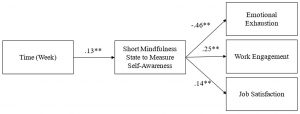Decrease Burnout in Healthcare Workers During Covid-19 with Mindfulness
By John M. de Castro, Ph.D.
“Healthcare professionals have been going above and beyond in order to safeguard everyone’s health and well-being during the coronavirus pandemic. Many have been stretched to capacity—and it’s not as if all the pre-COVID pressures have magically disappeared. Mindfulness can help healthcare professionals look after themselves and their colleagues during this time and beyond.” – Mindful
For healthcare professionals the Covid-19 pandemic has produced a number of difficult issues that may be helped by mindfulness practice. Being mindful or engaging in mindfulness practices can be helpful in coping with the physical and psychological manifestations of stress produced by long hours of working with very sick people with a highly infectious disease, the depression resulting from separation from family and loved ones, the post-traumatic stress disorder that can be produced by repeated exposure to suffering and death, and burnout that can result from the overwhelming quantity and seriousness of the symptoms. In addition mindfulness can help build empathy, compassion, patience, and flexibility that are so important for the treatment of the patients, resilience to withstand the stresses, and the ability to effectively cope with the strong emotions produced.
In today’s Research News article “Synchronous Mindfulness in Motion Online: Strong Results, Strong Attendance at a Critical Time for Health Care Professionals (HCPs) in the COVID Era.” (See summary below or view the full text of the study at: https://www.frontiersin.org/articles/10.3389/fpsyg.2021.725810/full?utm_source=F-AAE&utm_medium=EMLF&utm_campaign=MRK_1709299_a0P58000000G0YfEAK_Psycho_20210824_arts_A ) Klatt and colleagues recruited healthcare professionals and delivered to them a mindfulness training program, Mindfulness in Motion (MIM), either in person or over the internet and before the Covid-19 Pandemic or after. They were measured before and after training for resilience, perceived stress, work engagement, and burnout, including subscales of emotional exhaustion, depersonalization, and personal accomplishment.
They found that after the mindfulness training there were significant reductions in burnout and perceived stress, and significant increases in resilience and work engagement regardless of whether it was delivered before or after the Covid-19 Pandemic. After Covid there were significantly higher levels of emotional exhaustion, but the mindfulness training produced significantly greater reductions in emotional exhaustion and perceived stress. There were no significant differences between the effects of the training delivered virtually over the internet or in person.
These results demonstrate that mindfulness training improves the psychological health of healthcare workers regardless of whether it’s delivered in person or over the internet or whether it was delivered before or after the onset of the Covid-19 Pandemic. Although there weren’t control comparison conditions present, prior controlled research has demonstrated that mindfulness training produces significant decreases in burnout and perceived stress and increases in resilience and work engagement. So, the present results likely are due to the mindfulness training program.
These are important findings as healthcare workers, particularly during the Covid-19 Pandemic are under severe stress which makes burnout likely. In addition, these workers have little available time for training, so being able to deliver the program over the internet makes it more readily available. Hence, mindfulness training appears to be able to buffer the healthcare professionals from burnout and improve their psychological well-being even during the Covid-19 Pandemic.
So, decrease burnout in healthcare workers during Covid-19 with mindfulness.
“There is no doubt that the stress of the COVID-19 pandemic is causing a high level of stress and distress, particularly among health care workers due to our unique role in fighting the COVID-19 pandemic. During a pandemic like this, our capacity to stay calm, present, and compassionate is more important than ever.” – Dzung Vo
CMCS – Center for Mindfulness and Contemplative Studies
This and other Contemplative Studies posts are also available on Google+ https://plus.google.com/106784388191201299496/posts and on Twitter @MindfulResearch
Study Summary
Klatt M, Bawa R, Gabram O, Westrick A and Blake A (2021) Synchronous Mindfulness in Motion Online: Strong Results, Strong Attendance at a Critical Time for Health Care Professionals (HCPs) in the COVID Era. Front. Psychol. 12:725810. doi: 10.3389/fpsyg.2021.725810
Mindfulness in Motion (MIM) is an organizationally-sponsored mindfulness program for employees at a large academic health center that consistently produces significant reductions in burnout and perceived stress, alongside significant increases in work engagement and resilience. This study compared outcome measures of a synchronous virtual delivery of MIM, necessitated by COVID-19, to traditional in-person delivery of MIM. Outcome measures from the virtual COVID (AU20, WI21, SP21) MIM cohorts (n = 99) were compared with the in-person Pre-COVID (SP19, AU19, WI20) MIM cohorts (n = 124). Both Pre-COVID and COVID cohorts had similar attendance rates with an average attendance of 84 and 80%, respectively. Qualitative analysis of COVID cohorts reported community support during COVID as a substantial intervention benefit, which was important at a time when isolation dominated the healthcare professional experience. Total burnout was determined by scores on the subscales of the Maslach Burnout Inventory (MBI). There were no significant differences in depersonalization (p = 0.3876) and personal accomplishment (p = 0.1519) changes between Pre-COVID and COVID cohorts, however there was a significant difference in emotional exhaustion (p = 0.0315), with COVID cohorts improving more. In both Pre, and COVID cohorts, the percentage of people meeting burnout criteria from pre to post between groups were similar, yielding a non-significant difference (p = 0.2950). The Connor Davidson Resiliency Scale (CDRS) and Utrecht Work Engagement Scale (UWES) also produced no significant differences between groups (p = 0.4259, p = 0.1984, respectively). The Perceived Stress Scale (PSS) though yielded significant differences in reduction between groups (p = 0.0405), again with COVID cohorts showing greater improvement. Results of the first synchronous, virtually delivered MIM cohorts reflect that participants achieved very similar results and that MIM created a community in a time when it was greatly needed due to pandemic healthcare professional stress.









